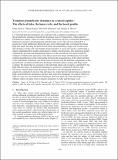Transient groundwater dynamics in a coastal aquifer: The effects of tides, the lunar cycle, and the beach profile
Author(s)
Abarca, Elena; Karam, Hanan N.; Hemond, Harold F.; Harvey, Charles F.
DownloadHarvey_Transient groundwater.pdf (1.616Mb)
PUBLISHER_POLICY
Publisher Policy
Article is made available in accordance with the publisher's policy and may be subject to US copyright law. Please refer to the publisher's site for terms of use.
Terms of use
Metadata
Show full item recordAbstract
Detailed field measurements are combined with a numerical modeling to characterize the groundwater dynamics beneath the discharge zone at Waquoit Bay, Massachusetts. Groundwater salinity values revealed a saline circulation cell that overlaid the discharging freshwater and grew and disappeared with the lunar cycle. The cell was initiated by a greater bay water infiltration during the new moon when high tides overtopped the mean high-tide mark, flooding the flatter beach berm and inundating a larger area of the beach. The dynamics of this cell were further characterized by a tracer test and by constructing a density-dependent flow model constrained to salinity and head data. The numerical model captured the growing and diminishing behavior of the circulation cell and provided the estimates of freshwater and saline water fluxes and travel times. Furthermore, the model enabled quantification of the relationship between the characteristics of the observed tidal cycle (maximum, minimum, and mean tidal elevations) and the different components of the groundwater circulation (freshwater discharge, intertidal saline cycling, and deep saline cycling). We found that (1) recharge to the intertidal saline cell is largely controlled by the high-tide elevation; (2) freshwater discharge is positively correlated to the low-tide elevation, whereas deep saline discharge from below the discharging freshwater is negatively correlated to the low-tide elevation. So, when the low-tide elevation is relatively high, more freshwater discharges and less deep saltwater discharges. In contrast when low tides are very low, less freshwater discharges and more deep salt water discharges; (3) offshore inflow of saline water is largely insensitive to tides and the lunar cycle.
Date issued
2013-05Department
Massachusetts Institute of Technology. Department of Civil and Environmental Engineering; Parsons Laboratory for Environmental Science and Engineering (Massachusetts Institute of Technology)Journal
Water Resources Research
Publisher
American Geophysical Union (Wiley platform)
Citation
Abarca, Elena, Hanan Karam, Harold F. Hemond, and Charles F. Harvey. “Transient Groundwater Dynamics in a Coastal Aquifer: The Effects of Tides, the Lunar Cycle, and the Beach Profile.” Water Resources Research 49, no. 5 (May 2013): 2473–2488. © 2013 American Geophysical Union
Version: Final published version
ISSN
00431397